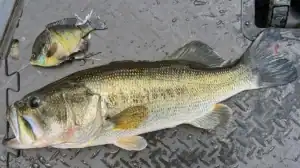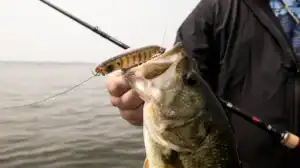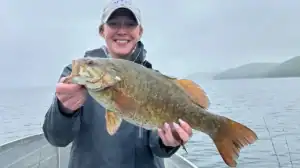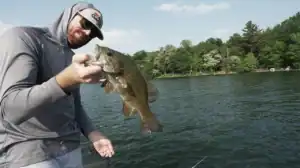Developed where the mighty Mississippi brushes the touring pro’s northeast Iowa homeland, it also produces fish in channelized and natural river systems far beyond Hawkeye territory.
“Water conditions dictate which punch I throw,” he says. “If the river is at normal pool or rising, I head for slop. If it’s a low or dropping, I target main channel sand.”
Skarlis’ slop strategy hinges on dense, bass-rich weed mats in large sloughs or main-channel flatwaters. Thick patches of pads, duckwort, hydrilla and milfoil in depths of one to three feet attract loose schools of bass as autumn approaches, and finding one fish often means finding the mother lode.
“Large, shallow flats may hold fish, but the best are adjacent to deeper water dropping down to, say, seven feet,” he says. “The worst spots are torn up by ‘rat tracks’ from other anglers’ topwaters.”
Speed is essential. “Cover mats fast,” he says. “Bass detect baits skittering overhead from at least seven feet away, so I fire search casts 10 feet apart and burn the bait back.”
A variety of frogs work in this situation, but Skarlis prefers Texas-rigging a 4-inch PowerBait Chigger Craw. Black/Red Fleck, Black/Blue Fleck and Green Pumpkin Party are top colors.
“Most times I fish weightless, but if I need to beef things up because of wind I add a small bullet sinker ahead of the bait,” he says.
A 7-foot medium-heavy casting rod equipped with an Abu Garcia Revo Winch spooled with 50-pound braided line complete the setup.
When a bass erupts on a high-speed retrieve, it often misses the mark. Skarlis responds with a follow-up cast past the blowup, then twitches the bait into the opening for a second round.
“I don’t watch the follow-up cast,” he says. “I turn perpendicular to the lure path and wait to feel the rod load up when the fish turns with the craw. If you see the strike, it’s easy to freak out and set too quickly.”
If tentative bass refuse to revisit the craw, Skarlis throws a fluke or jerk-shad-style bait like a 5-inch PowerBait HollowBelly Split-Tail in shades of white or shad. Such baits are also great for milking extra schoolies from spots where aggressive bass bust topwaters.
When steaming from one patch of slop to another, Skarlis often works a black, ½-ounce Jay’s Flippin’ Jig dressed with a pumpkinseed-pattern, 4-inch Power Grub through sparse weed growth. Intermediate areas such as running sloughs linking backwaters to the main channel may also hold fish, particularly around timber and isolated grassbeds.
Falling Water Failsafe
Though you may scratch a few fish from deep weed mat edges, low or falling water sends most backwater bass packing for the main channel. Many river rats fish wing dams following this exodus, but Skarlis scours the sand.
“Sandy bars or flats outside a tributary mouth hold surprising numbers of fish,” he says. “Seams where the main current and slack water meet are best.”
He notes that silted-in sections of wing dams, often tight to the bank in one to two feet of water, are also worth checking.
“Position the boat below the sand, cast upstream beyond the area you want to fish, and work the lure downstream,” he explains.
Early in the day, he favors topwaters like Heddon’s Super Spook Jr., along with divers such as Reef Runner’s 500 Series Little Ripper and 700 Series Ripstick.
“As the fish get more aggressive, try a Flicker Shad, Cotton Cordell Big O or 400 Series Ripshad,” he says.
Crank the bait to bottom so it trails in the sand and digs into fish-holding depressions and dunes.
“This is a shad-based scenario and the bass are in these areas to eat,” he adds. “Baits with shad patterns work best, especially in bright sunlight and clear water—with a metallic chrome or gold finish. Overcast skies or dirty water call for firetigers and white-painted basecoats.”
The main-river sand bite calls for a little flexibility, so Skarlis trades the heavy braid for 17-pound abrasion resistant mono and a 7-foot glass/graphite hybrid rod.
Together, the slop and sand patterns offer a failsafe one-two punch for catching river largemouths until the weedbeds disappear in late autumn.










